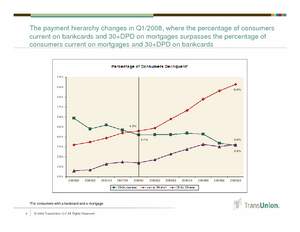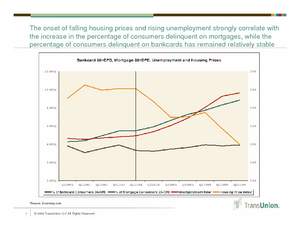Contact Information: Contact Dave Blumberg TransUnion Telephone (312) 985-3059
TransUnion Study Finds More Consumers Making Payments on Their Credit Cards Before Their Mortgages
"New" Payment Hierarchy May Be Here to Stay
| Source: TransUnion
CHICAGO, IL--(Marketwire - February 3, 2010) - A new study developed by TransUnion confirms
that the "new" payment hierarchy -- where consumers pay their credit cards
prior to their mortgages -- is continuing, with the trend occurring more
readily than ever before.
"Conventional wisdom has always been that, when faced with a financial
crisis, consumers will pay their secured obligations first, specifically
their mortgages," said Sean Reardon, the author of the
study and a consultant in TransUnion's analytics and decisioning services
business unit. "However, a recent TransUnion analysis has found that
increasingly more consumers are paying their credit cards before making
mortgage payments. This analysis reaffirms the results of a previous
TransUnion study that examined data between the third quarter of 2006 and
the first quarter of 2008."
The percentage of consumers current on credit cards
and delinquent on mortgages first
surpassed the percentage of consumers current on their mortgages and
delinquent on credit cards in the first quarter of 2008. This "flip" is
representative of the change in the conventional wisdom around the payment
hierarchy, or which debt obligations consumers would choose to pay first.
The latest study, conducted on consumers that had at least one credit card
and one mortgage, examined 30-day credit card and mortgage delinquency data
between the second quarter of 2008 (Q2/2008) and the third quarter of 2009
(Q3/2009). Although many industry analysts believed that a reversion to
the conventional payment hierarchy would ensue once we had passed through
the worst of the recession -- that has not, in fact, been the case. To the
contrary, this study found that the hierarchy reversal has become even more
widespread, with the percentage of consumers who are delinquent on their
mortgages and current on their credit cards rising to 6.6 percent in
Q3/2009 (from 4.3 percent in Q1/2008). Conversely, the percentage of
consumers who are delinquent on their credit cards and current on their
mortgages has decreased to 3.6 percent in Q3/2009 (from 4.1 percent in
Q1/2008).
"This same trend is evident within the lowest scoring risk segment," added
Reardon. "Moreover, it should be noted that the 'flip' in payment
hierarchy in the lowest scoring segment was evident earlier during Q4/2007,
compared to Q1/2008 for the total market."
The study found that the magnitude of delinquency in the lowest scoring
segment is significantly higher than that of the total market. The
delinquency rate for consumers in this segment who were delinquent on their
mortgages but current on their credit cards during Q4/2007 was 19.1
percent, and rose to 29 percent in Q3/2009. In a trend similar to that of
the total market, the percentage of consumers delinquent on their credit
cards but current on their mortgages decreased from 18.1 percent in Q1/2008
to 14.5 percent in Q3/2009.
The payment hierarchy shifts are even more pronounced in states such as
California and Florida that experienced a more severe housing bubble
effect. Within California, the percentage of consumers delinquent on their
mortgages but current on their credit cards increased from 3.5 percent in
Q3/2007 to 10.2 percent in Q3/2009 (a 191 percent increase). In Florida,
this same variable increased from 5.1 percent in Q3/2007 to 12.4 percent in
Q3/2009 (a 143 percent increase). In this same timeframe, the United States
experienced a 68 percent increase (from 4.0 percent in Q3/2007 to 6.6
percent in Q3/2009).
In contrast, the number of California consumers delinquent on their credit
cards but current on their mortgages declined from 3.3 percent in Q3/2007
to 2.7 percent in Q3/2009. In Florida, this variable declined from 5.0
percent in Q3/2007 to 3.9 percent in Q3/2009.
"The implosion of the mortgage industry over the last 24 months, the
resetting of adjustable-rate mortgages and the weak job market have all
come together to redefine how consumers are managing their finances and
meeting (or not meeting) their credit obligations," said Ezra Becker, director
of consulting and strategy in TransUnion's financial services business
unit. "The insight gained through this analysis reveals a lot about
changing consumer preferences. The financial services industry must
recognize and adjust to the payment hierarchy shift with judicious
modifications to business models, new assessments of specific areas of
risk, and by strategic revisions to acquisition and account management
strategies."
The source of the underlying data used for this analysis was TransUnion's Trend Data, a proprietary historical
database consisting of 27 million anonymous consumer records randomly
sampled every quarter from TransUnion's national consumer credit database.
Using TransUnion's standard definitions of credit card and mortgage trades,
TransUnion was able to create and evaluate the custom attributes that are
the basis of this study.
About TransUnion
As a global leader in credit and information management, TransUnion creates
advantages for millions of people around the world by gathering, analyzing
and delivering information. For businesses, TransUnion helps improve
efficiency, manage risk, reduce costs and increase revenue by delivering
comprehensive data and advanced analytics and decisioning. For consumers,
TransUnion provides the tools, resources and education to help manage their
credit health and achieve their financial goals. Through these and other
efforts, TransUnion is working to build stronger economies worldwide.
Founded in 1968 and headquartered in Chicago, TransUnion has employees in
more than 25 countries on five continents. www.transunion.com/business

